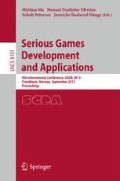Abstract
Ambient sound plays a critical part in all media related to the moving image, video games, and live performance. It defines its place and time, temporalizes it to towards a future goal and is key in creating audience immersion and belief in what we see. The process of recording, manipulating or designing audio elements is usually handled by competent professionals. Can a different approach be had to the way we design sound ambiences and what relationship and role does ambient sound have to media such as film and games? Using object-oriented programming environment, Max/MSP, a low-cost serious gaming interface was designed and implemented – the Ambience Designer. This rids the process of its esoteric nature and together with an especially crafted tabletop interface allows amateurs to design and interact with the ambient sounds of birds, wind and traffic for home movies and indie games. The Ambience Designer removes the esoteric ways of audio design in a Digital Audio Workstation (DAW) and use intuitive user input that connect with our every day subjective experience of sound - such as distance, placement, and intensity - in place of parameters that only professionals could understand and use. Future developments include moving the Ambience Designer to a commercial multi touch table/tablet such as Microsoft Surface or Apple iPad which will enable us to utilise more intuitive, multi-touch gestures such as tap, scroll, pan, rotate, and pinch. The Ambience Designer was evaluated among working professionals, amateurs and the general public and initial findings were promising. During the survey, participants also suggested some future applications of the Ambience Designer, such as a creative and educational tool for children or people with special needs, for therapeutic purposes, to trigger memories in elderly, for digital storytelling and post-production sound dubbing for picture.
Access this chapter
Tax calculation will be finalised at checkout
Purchases are for personal use only
Preview
Unable to display preview. Download preview PDF.
References
Schafer, R.M.: The New Soundscape Note: The definition has also been expanded to include sonic constructions such as musical compositions and sound collages (1969)
Krause, B.: The Great Animal Orchestra. Profile Books, London (2012)
Warren, P., Katti, M., Ermann, M., Brazel, A.: Urban Bioacoustics: it’s not just noise. Animal Behaviour 71, 491–502 (2006)
Pratella, B.: Technical Manifesto of Futurist Music (1911), http://media.hyperreal.org/zines/est/articles/prehist5.html (accessed May 7, 2013)
Russolo, L.: The Art of Noise (1913), http://www.artype.de/Sammlung/pdf/russolo_noise.pdf (accessed May 7, 2013)
Schaeffer, P.: A la recherche d’une musique concrète. Éditions du Seuil, Paris (1952)
Chion, M.: Audio-Vision: Sound on Screen, 2nd edn. Columbia University Press, New York (1994)
Altman, R. (ed.): Sound Theory, Sound Practice. Routledge (1992)
Murch, W.: In the Blink of an Eye, 2nd edn. Silman-James Press, Los Angeles (2001)
Kerins, M.: Beyond Dolby (Stereo). Indiana University Press, Bloomington (2011)
Mix Online, SFP: Skip Lievsay (2008), http://mixonline.com/post/features/sfp-skip-lievsay/ (accessed May 24, 2013)
Collins, K.: Game Sound. The MIT Press, Cambridge (2008)
Bridge, C.: Creating Audio That Matters (2012), http://www.gamasutra.com/view/feature/174227/creating_audio_that_matters.php (accessed May 24, 2013)
Designing Sound, “Limbo” – Exclusive Interview with Martin Stig Andersen (2011), http://designingsound.org/2011/08/limbo-exclusive-interview-with-martin-stig-andersen/ (accessed May 24, 2013)
Farnell, A.: An Introduction to Procedural Audio and its Application in Computer Games (2007), http://obiwannabe.co.uk/html/papers/proc-audio/proc-audio.html (accessed July 20, 2012)
Pure Data (no date), http://puredata.info/ (accessed May 24, 2013)
Farnell, A.: Designing Sound. The MIT Press, Cambridge (2010)
American National Standards Institute, ANSI/ASA S12.18-1994 Outdoor Measurement of Sound Pressure Level (1994), http://www.ansi.org
American National Standards Institute, ANSI/ASA S1.26-1995 Calculation of the Absorption of Sound by the Atmosphere (1994), http://www.ansi.org
Geiger, G., Alber, N., Jordà, S., Alonso, M.: The Reactable: A Collaborative Musical Instrument for Playing and Understanding Music. Heritage & Museography 4, 36–43 (2010)
Kaltenbrunner, M., Bencina, R.: reacTIVision, http://reactivision.sourceforge.net/ (accessed May 22, 2013)
Tincknell, E., Filimowicz, M. (eds.): The Soundtrack. Walter Murch interviewed by Gustavo Costantini, vol. 3(1). Intellect Ltd., UK (2010)
Author information
Authors and Affiliations
Editor information
Editors and Affiliations
Rights and permissions
Copyright information
© 2013 Springer-Verlag Berlin Heidelberg
About this paper
Cite this paper
Jönsson, A., Breslin, R., Ma, M. (2013). The Ambience Table: A Serious Gaming Interface for Aiding Sound Design. In: Ma, M., Oliveira, M.F., Petersen, S., Hauge, J.B. (eds) Serious Games Development and Applications. SGDA 2013. Lecture Notes in Computer Science, vol 8101. Springer, Berlin, Heidelberg. https://doi.org/10.1007/978-3-642-40790-1_15
Download citation
DOI: https://doi.org/10.1007/978-3-642-40790-1_15
Publisher Name: Springer, Berlin, Heidelberg
Print ISBN: 978-3-642-40789-5
Online ISBN: 978-3-642-40790-1
eBook Packages: Computer ScienceComputer Science (R0)

